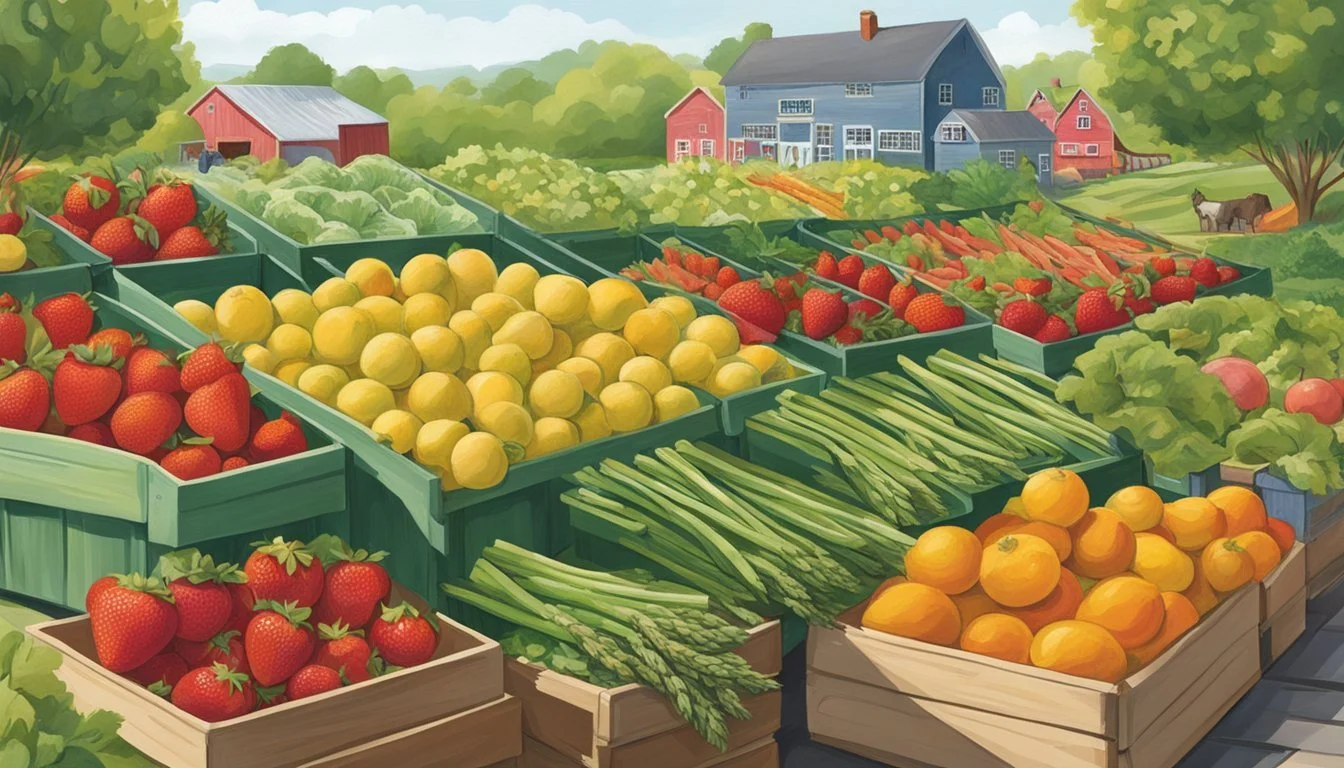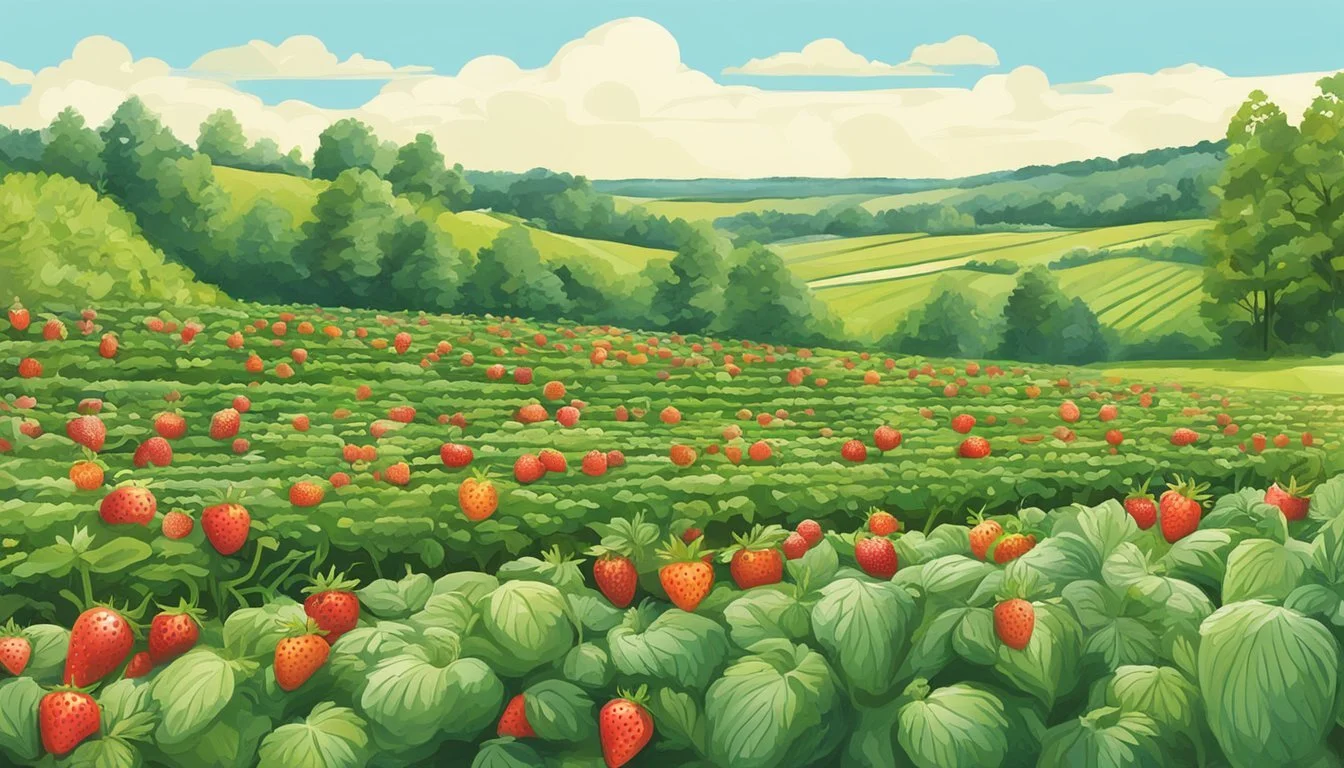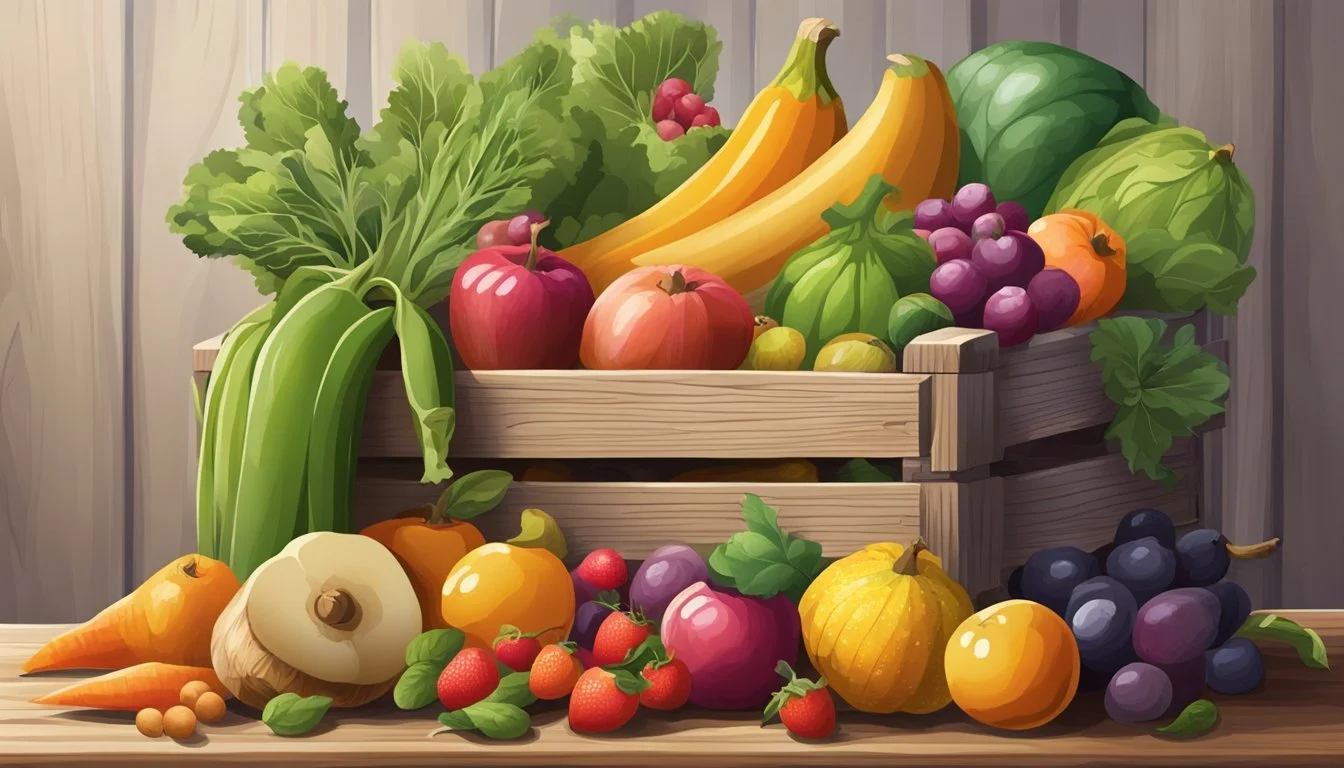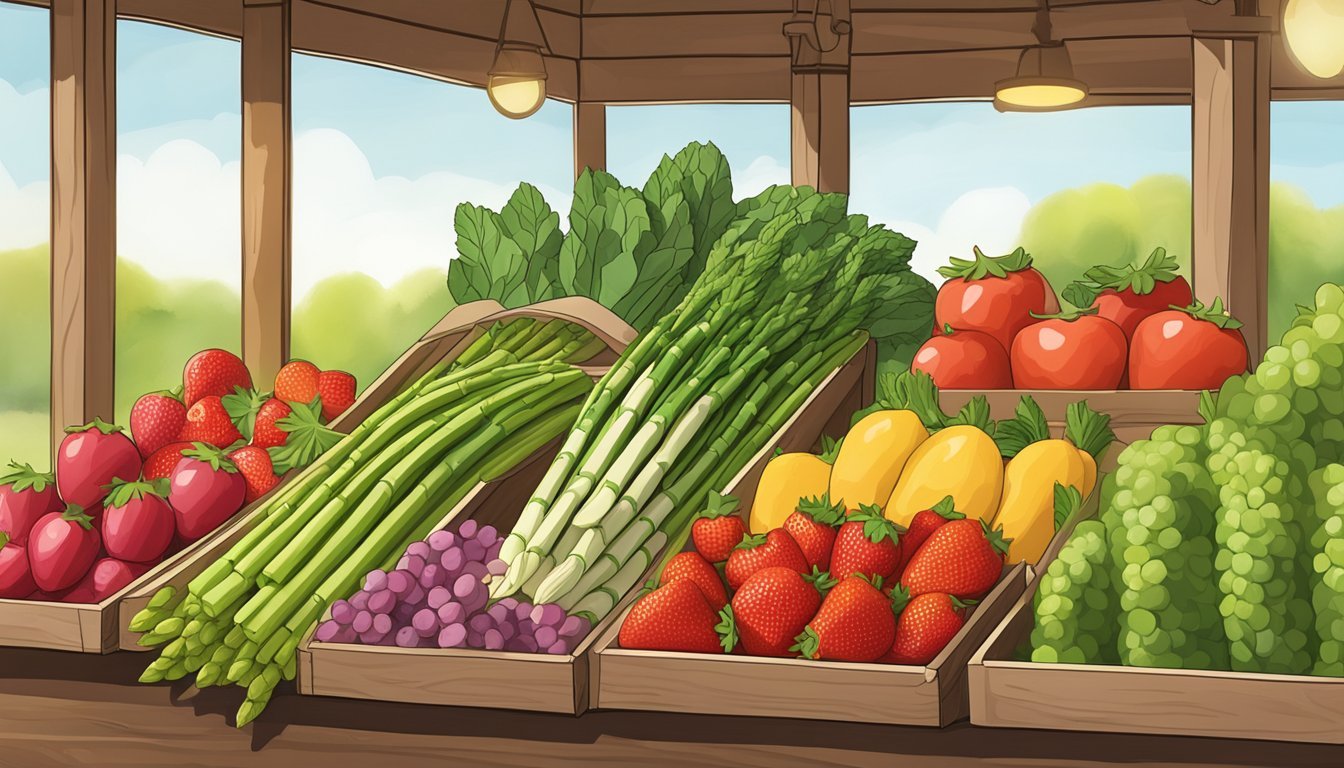Rhode Island Seasonal Fruit & Vegetables in April
A Fresh Guide
This Article is Part of our Rhode Island Seasonal Fruit & Veg Calendar
As April arrives, Rhode Island transitions firmly into spring, bringing with it a variety of fresh produce that captures the essence of the season. This is a time when local markets and farms begin to showcase an array of fruits and vegetables that are at their peak, ensuring that the community has access to the freshest and most flavorful options.
In Rhode Island, April's seasonal produce offers a taste of both the tail end of winter's bounty and the beginning of spring's fresh offerings. Root vegetables and hearty greens that have been mainstays through the colder months make room for the bright, tender arrivals signifying spring's return. Consumers can anticipate local staples such as asparagus (how long does asparagus last?) and rhubarb, which are among the first to emerge, marking the change in seasons with their vibrant colors and textures.
The importance of eating in season extends beyond mere taste and nutrition; it also supports regional farmers and reduces the environmental impact associated with long-distance food transportation. Rhode Island's climate and soil yield a specific selection of produce in April, and incorporating these items into meals not only enhances the dining experience but also nourishes the body with high-quality, locally-sourced produce.
Seasonal Overview of Rhode Island Produce
April marks a transitional period for Rhode Island farms, as they prepare for the burst of growth that spring promises. Local markets begin to showcase the first signs of fresh, in-season produce that one can expect to flourish in the coming months.
Root Vegetables: Long-lasting staples like turnips and radishes remain available, often stored effectively from prior harvests.
Greens: As one of the first fresh crops of the season, a variety of greens such as spinach and kale become readily accessible at local markets. These leafy vegetables favor the cooler temperatures of early spring.
Herbs: Cool-weather herbs like parsley and chives start to make their appearance, providing fresh, aromatic flavors to the local cuisine.
What to Anticipate in May: Approaching May, the selection broadens significantly. One might find an increased variety of produce as local farms harvest items that require slightly warmer weather.
Month Expected Produce March Leeks, parsnips, greenhouse products April Turnips, radishes, spinach, kale May Asparagus, rhubarb, strawberries
The seasonal calendar is shaped by various factors such as weather conditions and farming practices, which influence the precise timing of harvests. Nevertheless, consumers should keep in touch with local farm updates to ensure the freshest pick.
Rhode Islanders take pride in their agricultural calendar, emphasizing the value of farm-to-table eating. April is a month of increasing variety, with the anticipation of May’s more colorful and voluminous harvests. It's an excellent time for consumers to support local producers and enjoy the freshness of seasonal goods.
What's Fresh in April?
April in Rhode Island marks a transition period where the last of winter's offerings meet the earliest signs of spring. Consumers and culinary enthusiasts can delight in the availability of both the final batches of cold-hardy crops and the initial harvest of springtime produce. Visiting local farmers markets provides an opportunity to find the freshest ingredients for the season.
Fruits
Strawberries: These sweet berries begin to appear in markets, tantalizing with their freshness and vibrant red hue.
Rhubarb: Often paired with strawberries, its tartness is ideal for pies and jams.
Vegetables
Asparagus: A prized spring vegetable, known for its tender and flavorful spears.
Arugula: This peppery green adds a zesty flavor to salads and sandwiches.
Chard: Offering both nourishment and color, chard can be used in a variety of dishes.
Leeks: With a mild onion-like taste, they enhance the flavor of soups and stews.
Lettuce and Salad Greens: Fresh and crisp, ideal for spring salads.
Peas: Sweet and snappy, they are perfect for adding freshness to any meal.
Spinach: Versatile and nutrient-rich, it can be enjoyed raw or cooked.
Scallions: Also known as green onions, they are perfect for garnishing and add a mild kick to dishes.
Herbs
Cilantro: Brings a bright, citrusy flavor to dishes, common in salsas and Asian cuisine.
Dill: Works well with fish and in creamy dressings, its feathery fronds are packed with flavor.
Mint: Fresh mint leaves can liven up beverages, desserts, and savory dishes alike.
Parsley: More than just a garnish, it brings a fresh note to many dishes.
Rosemary: Its needle-like leaves offer a woodsy aroma, ideal for meats and potatoes.
Sage: Known for its earthy flavor, a great complement to poultry and pork.
Local Farmers Markets
In Rhode Island, April marks the continuation of the winter farmers market season and the anticipation of the upcoming summer markets. Notably, Farm Fresh RI oversees and connects local consumers to several markets across the state, emphasizing a commitment to freshly harvested produce and goods.
One central location for these markets is The Pawtucket Farmers Market at The Guild, located at 461 Main St. During the month of April, consumers can enjoy a biweekly schedule on Fridays from 12-3pm, an opportunity to purchase local goods midway through their winter season, which operates from November to late April.
Folks in Newport have access to the Aquidneck Growers Market, an integral part of the local food system, which also runs through the early months of the year. Consumers eagerly await the transition to the variety of summer markets, such as those operated by Hope & Main, which come into full swing by early June.
The Providence Farmers Market, although not specified in the provided results, is known to be another hub for local producers to sell a variety of fresh produce. These markets often support a wide range of products outside of fruits and vegetables, including dairy, meats, flowers, baked goods, and artisanal crafts, reflecting Rhode Island's diverse agricultural offerings.
In summary, Rhode Island's farmers markets, such as those managed by Farm Fresh RI, provide an indispensable platform for community engagement and accessibility to local, seasonal produce.
Market Location Operating Months Details Pawtucket November - April Biweekly Fridays, 12-3pm Newport Winter Season Specific schedule not provided
Harvesting Periods in Rhode Island
In Rhode Island, the months of April and May signify an exciting period for local produce as gardens and farms begin to yield fresh crops. April is typically when the spring harvest gains momentum, leading into the plentiful months of early summer.
Spring Harvest (April to May):
Leafy Greens: Spinach, Lettuce, and Kale emerge as some of the earliest picks.
Root Vegetables: Radishes and beets can be ready for harvest.
Herbs: Parsley, Cilantro, and Chives are often at their peak.
As spring progresses into Early June, the variety of fruits and vegetables available from Rhode Island's farms expands considerably.
Transition to Summer (June):
Strawberries: Often ready by early June, signaling the start of the summer fruit season.
Peas: Sugar snap and garden peas reach harvesting time.
The harvesting periods stretch into the Peak Summer Months (July to August) where the options for local produce are at their zenith:
Stone Fruits: Peaches and possibly early varieties of plums.
Tomatoes: Various types begin to ripen in abundance.
Summer Squash: Including zucchini and yellow squash.
By September, which is still warm, expect an overlap of late-summer and early-fall produce, offering an extended harvest period for many summer crops.
Remember, these harvesting periods are subject to change based on weather and other growing conditions. Farmers often have the most current updates on the readiness of their crops. It is advisable to contact local farms directly for the most accurate information on produce availability.
Tips for Picking and Storing
When harvesting vegetables in April in Rhode Island, one should opt for those that feel firm and have vibrant coloration, indicative of peak freshness. Lettuce, a common spring vegetable, should be picked when leaves are tender, yet crisp. To store lettuce, wrap it in paper towels and place it inside a plastic bag in the refrigerator to maintain moisture and crispness.
Root vegetables like radishes should be firm and blemish-free. They can be stored in a cool, dark place and should be kept in perforated plastic bags to allow air circulation. Beet greens should be separated from the roots before storage to extend shelf life.
As for fruits, April is not a prime month in Rhode Island, but for those that are available, such as the last of stored apples, they should have firm skin and be free from spots. Refrigerate fruits in the crisper drawer to keep them fresh longer. For berries that start to appear, refrain from washing until right before consumption to avoid mold.
Herbs should be picked early in the morning when their essential oils are strongest. Store them by wrapping in a damp paper towel and placing them inside a plastic bag before refrigerating.
Item Picking Sign Storage Method Vegetables Firm texture, vibrant color Plastic bag, refrigerator (unless otherwise noted) Fruits Firm skin, no soft spots Crisper drawer in refrigerator Herbs Strong scent Damp paper towel, plastic bag, refrigerator
Preserving the bounty of April's produce in Rhode Island ensures one can enjoy fresh, seasonal tastes while reducing food waste. Proper picking and storage techniques are key to maximizing both flavor and shelf life.
Benefits of Eating Seasonally
Eating seasonally brings a multitude of benefits that resonate from personal health to the larger environment. Individuals who choose seasonal produce are often rewarded with fresher fare. Seasonal fruits and vegetables are typically harvested at their peak, providing the best flavor and nutritional content. This is because these items have had the optimal time to mature and ripen naturally.
The consumption of local and seasonal foods also supports local farms and businesses, reinforcing the regional economy. Buying from local farmers markets or joining a community-supported agriculture group (CSA) keeps the financial benefits within the community, fostering job creation and sustainability.
Health-wise, seasonal eating introduces a variety to the diet. This is not only pleasing to the palate but also offers a diverse array of nutrients. Each season’s produce brings its own set of vitamins and minerals, which can align with the body’s seasonal health needs. Eating a variety of fruits and vegetables is linked to a decreased risk of many chronic diseases.
Environmental Implications
Environmentally, seasonal produce often requires less energy and resources to grow and transport, reducing its carbon footprint. When food is grown locally and does not have to be shipped long distances, it conserves energy and produces fewer greenhouse gases.
Table: Seasonal Eating Benefits
Aspect Benefit Nutrition Higher nutritional value and taste Economic Supports local economy and reduces transportation costs Health Increases dietary variety and reduces disease risks Environmental Impact Lowers carbon footprint and conserves resources
Focusing on seasonal eating ultimately promotes a more sustainable and conscious approach to food consumption.
Supporting Local Agriculture
When consumers in Rhode Island choose to support local farms by purchasing seasonal fruits and vegetables, they contribute to the economic stability and growth within the state. Local agriculture thrives on community involvement, and through programs such as Farm Fresh RI's Market Mobile service, residents can easily access farm-to-table produce with the convenience of online ordering.
This patronage has a ripple effect on the local economy. By spending within the state, consumers ensure that their money circulates within local businesses, bolstering Rhode Island's fiscal health. The local food system benefits from initiatives like the Local Agriculture and Seafood Act (LASA) Grant Program, which extends grants to further strengthen and sustain the area's agricultural offerings.
Seasonal Availability: April marks the availability of fresh greens and early vegetables, which are mainstays of the spring diet.
Community Engagement: Involvement in local agriculture can be as simple as participating in community-supported agriculture (CSA) programs or visiting farmer's markets.
Sustainability is a key outcome of supporting local farms. Reduced transportation of goods means a lower carbon footprint and fresher produce for consumers. Moreover, local farms are more likely to employ sustainable farming practices that benefit Rhode Island's environment.
Local initiatives not only focus on providing fresh produce to the consumers but also make concerted efforts to reach vulnerable populations. Programs tailored to senior centers, for instance, ensure equitable access to nutritious, locally grown fruits and vegetables across the community.
In summary, Rhode Islanders can take pride and find confidence in supporting their state's agriculture by engaging with and purchasing from their local farms and markets.
Beyond Produce: Other Seasonal Items
In Rhode Island, April is not only a month for spring produce but also a time for fresh local dairy, meats, and artisanal goods. Consumers can find a variety of farm-fresh items that are at their peak in flavor and quality.
Dairy & Eggs
Rhode Island farms offer fresh dairy products that include a variety of cheeses, from soft cheeses like chevre to firmer options such as cheddar. Artisan cheese producers take pride in their craft, often using milk from cows, goats, or sheep grazed on the spring grasses. Eggs are another staple—chicken eggs are widely available, and some farms also offer duck (What wine goes well with duck?) eggs, which are known for their rich flavor and larger size.
Meats
The local meat offerings encompass pasture-raised chicken and duck, which are known for their superior taste compared to mass-produced alternatives. Rhode Island's coastal location means that seafood is always a highlight, with fresh catches coming in regularly. April marks the beginning of the fishing seasons, so customers can expect the freshest seafood, from flounder to striped bass.
Other Goods
Beyond dairy and meats, Rhode Island's local markets in April might carry unique items such as honey, a natural sweetener with subtle flavor notes that reflect the local flora. Honey is not only a tasty treat but also an important product of the state's agricultural environment. Various farms and small-scale producers offer honey in its raw, unfiltered form, which retains more nutrients and enzymes.
Recipes and Cooking Ideas
In Rhode Island, April brings an abundance of fresh seasonal produce that can elevate any meal plan with vibrant flavors and colors. Utilizing these ingredients ensures cooking with the freshest vegetables and fruits available, thus maximizing both nutrition and taste.
For those looking to incorporate seasonal vegetables, asparagus appears in many recipes due to its tender texture and grassy undertones. It can be simply grilled or roasted with a dash of olive oil and sea salt, or shaved into ribbons for a refreshing salad. On the other hand, leeks, with their mild onion-like flavor, are excellent in soups or as a subtle addition to potato dishes.
Here is a curated list of recipe ideas that highlight April's bounty:
Meal Type Recipe Idea Key Seasonal Ingredients Breakfast Strawberry Overnight Oats (how long do oats last?) Strawberries Lunch Greek Chicken Salad in a Jar Mixed greens Dinner Spring Vegetable Lasagna Spinach, asparagus
Herbs like parsley, chives, and cilantro are now at their peak and can be used to garnish dishes or incorporated into dressings and sauces, adding a fresh element to any dish.
Desserts and snacks welcome the sweetness of April fruits. For example, a homemade strawberry chia pudding not only introduces the season's flavors but is also a nutritious option.
Seasonal cooking doesn't have to be complex. Simple methods such as steaming or sautéing can let the natural flavors of the produce shine through, be it vegetables like spinach and radishes or fruits like strawberries. Both novice and seasoned chefs can rejoice in simple, wholesome recipes that embody the essence of spring in Rhode Island.











